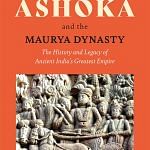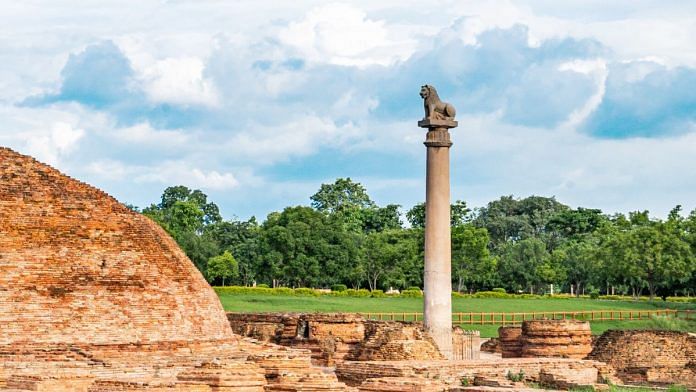Under the Mauryas, especially Chandragupta and Ashoka, India was one of the wealthiest political entities of the ancient world. One economic historian has estimated that in the year 1 CE, India accounted for 32 per cent of the world’s GDP (and one-third of the world’s population), and this share may have been even higher in Maurya times. This period saw the expansion of agriculture, the growth of population and settlement sizes, craft specialization, the emergence of writing and a surge of internal and external trade, thanks to an extensive network of land and sea trade routes.
Our knowledge of Mauryan society and economy comes from several sources: Megasthenes’ Indika, Ashoka’s inscriptions, Buddhist and Jain texts and the Arthashastra. Although there is disagreement among scholars about the historicity of this work, Mark McClish and Patrick Olivelle write: ‘The teachings of the Arthashastra, as decontextualized and idealized as they may be, also serve as an important record of practices and customs current in Kautilya’s time.’
Another valuable secondary source is the linguist Panini’s Ashtadhyayi (Eight Chapters). Panini is believed to have been born in Gandhara and studied and taught at the university in Taxila. His goal was to define the morphology and syntax of the Sanskrit language and thereby distinguish between the usage of the spoken languages (Prakrits) of his day and Sanskrit, the language of the elite and of religious texts.
Panini compiled a list of words in common use and then created more than 4,000 grammatical rules to classify various linguistic phenomena; they, in turn, could be used to generate other words. After his work was discovered in the West in the mid-nineteenth century, Panini was called the ‘father of modern linguistics’.
To describe the living language and create a lexicon, Panini wandered around the country collecting words about all aspects of life and society, including customs, folklore, government, medicine, agriculture, food, sports, clothing, family relationships and so on. He talked with people at all social levels: musicians, hunters, shoemakers, cooks, merchants, authors, beggars, devotees, farmers, priests, counsellors and more.
Like the Arthashastra, the Ashtadhyayi was based on the work of earlier grammarians. Historians originally placed Panini’s work in the sixth century bce, but more recent scholarship suggests it could have been compiled as late as 350 BCE – just before or during the time of Alexander’s invasion and much closer to the time of Ashoka than was previously thought. Greek writers mention Panini’s friendship with one of the Nanda kings, and say that he visited Pataliputra to take part in a conference at which philosophers met to suggest ways of improving crop yields and promoting the public interest. One of the most famous commentaries on the Ashtadhyayi was the Mahabhasya by another scholar, Patanjali, who likely lived in the second century bce. This work is also a source of information on the Mauryan period.
Whether Panini wrote his work down is a subject of much controversy. While some scholars, notably Harry Falk, argue that it was transmitted orally, it is difficult to imagine that a work of such complexity could be conveyed without being written down.
Also read: Yali—mythical sculptures guarding Hindu, Buddhist temples in India
Cities
Mauryan cities, especially the capital, Pataliputra, were lively, bustling places. In one of his sutras, the Buddha describes the city of Kushavati in the following way:
Both by day and by night . . . the royal city Kushavati [a city in the
Kosala kingdom in what is now Uttar Pradesh] resounded with ten
cries; that is, the noise of elephants, the noise of horses, and the
noise of chariots; the sounds of drum, tabor and lute; the sound
of singing and the sound of the cymbal and gongs; and lastly with
the cry ‘Eat, drink and be merry.’
Buddhism and Jainism were popular among urban dwellers, and some Brahminical texts expressed disapproval of the urban ethos, declaring, for example, that the study of the Veda should be avoided in market towns.
If the purpose of life in the Arthashastra is to attain artha, worldly success, and that of the Brahminical texts to achieve Dharma, or righteousness, the third aim of life, kama (pleasure), is the subject of another famous work, the Kama Sutra. Like the Arthashastra, its author and date and place of composition are problematic. Historians place its composition between 400 BCE and 200 CE, in a city in northern India or perhaps Pataliputra. Again, this work is based on many ancient texts.
 This excerpt from Ashoka and the Maurya Dynasty: The History and Legacy of Ancient India’s Greatest Empire by Colleen Taylor Sen has been published with permission from by Speaking Tiger Books, 2022.
This excerpt from Ashoka and the Maurya Dynasty: The History and Legacy of Ancient India’s Greatest Empire by Colleen Taylor Sen has been published with permission from by Speaking Tiger Books, 2022.



